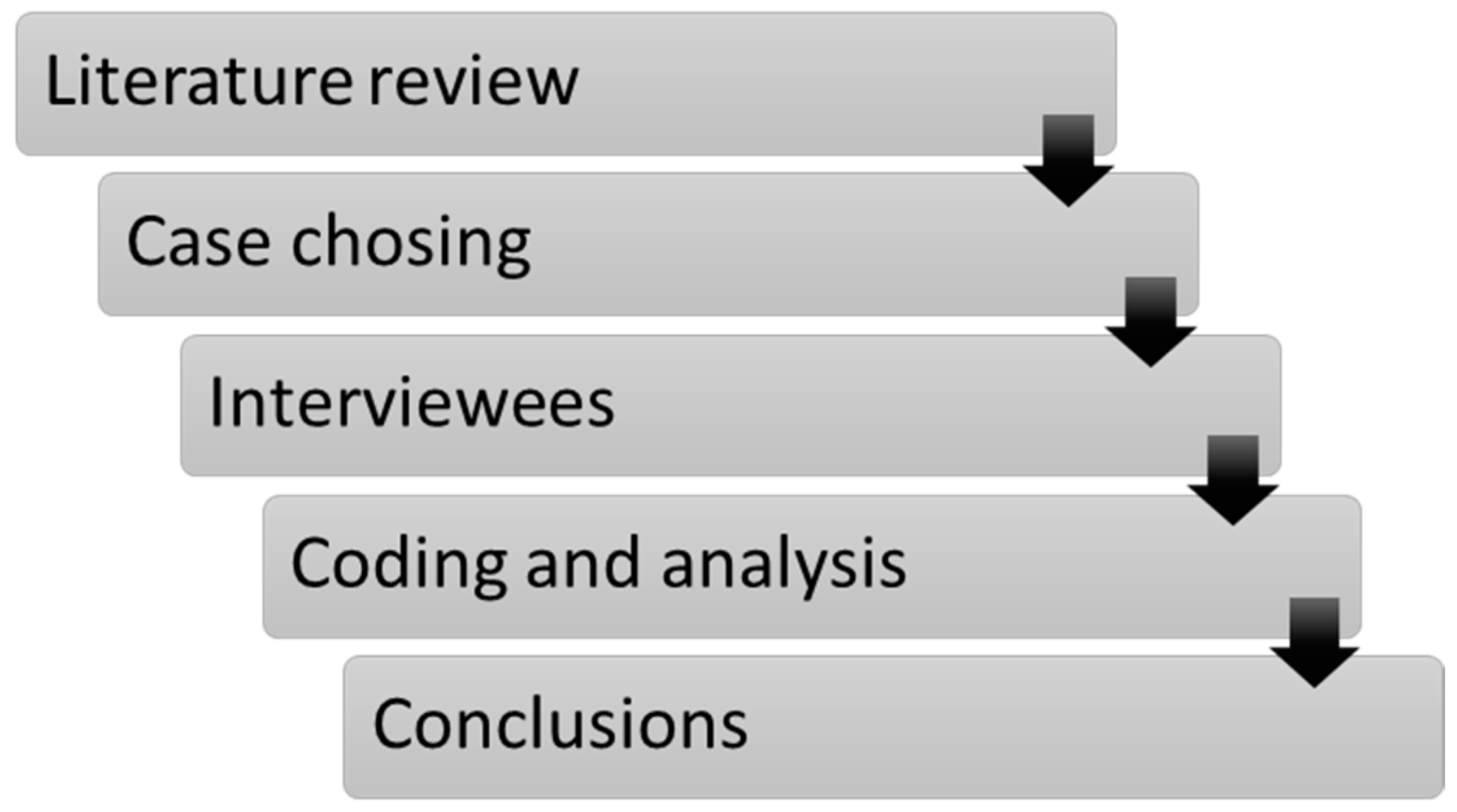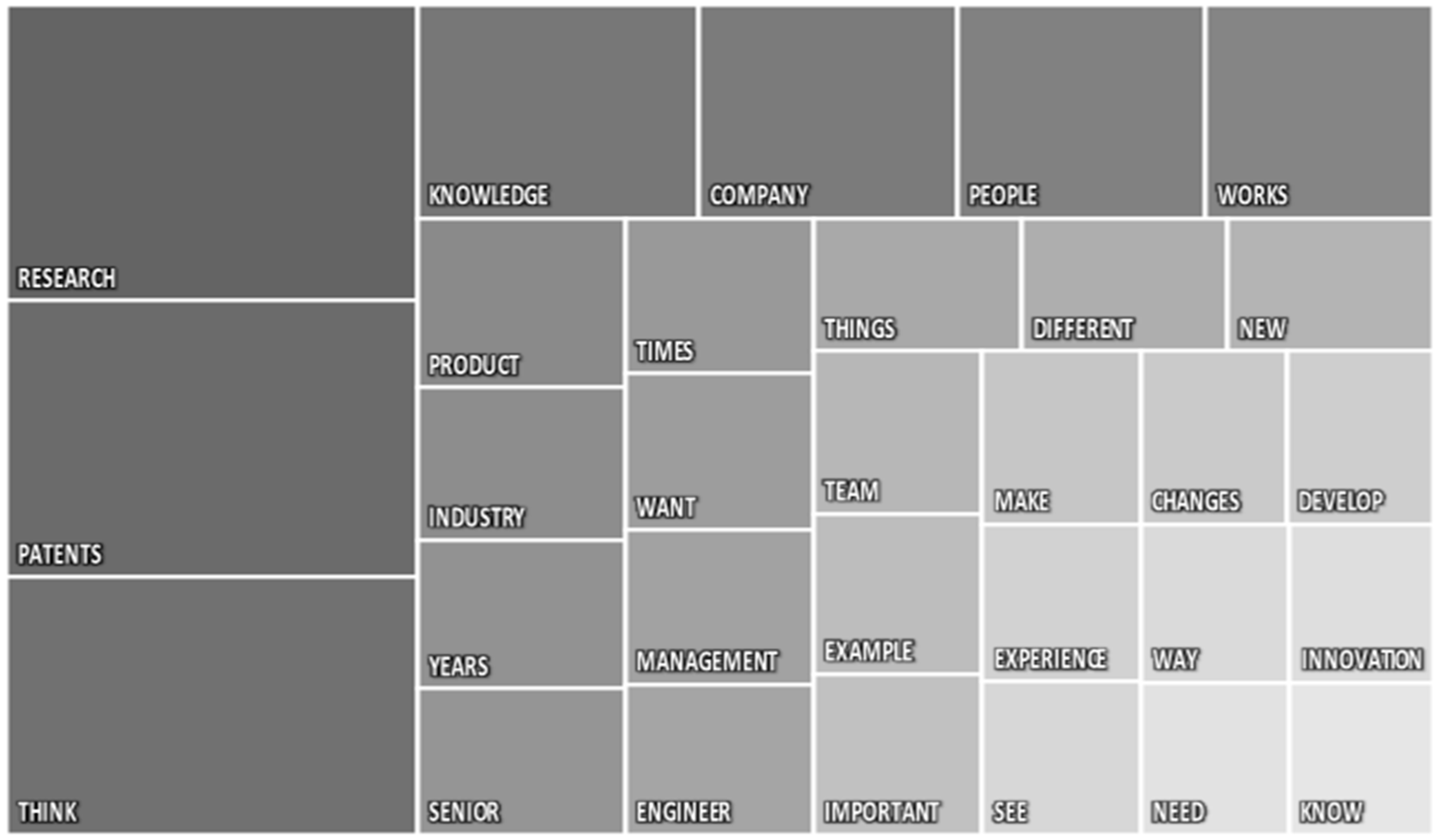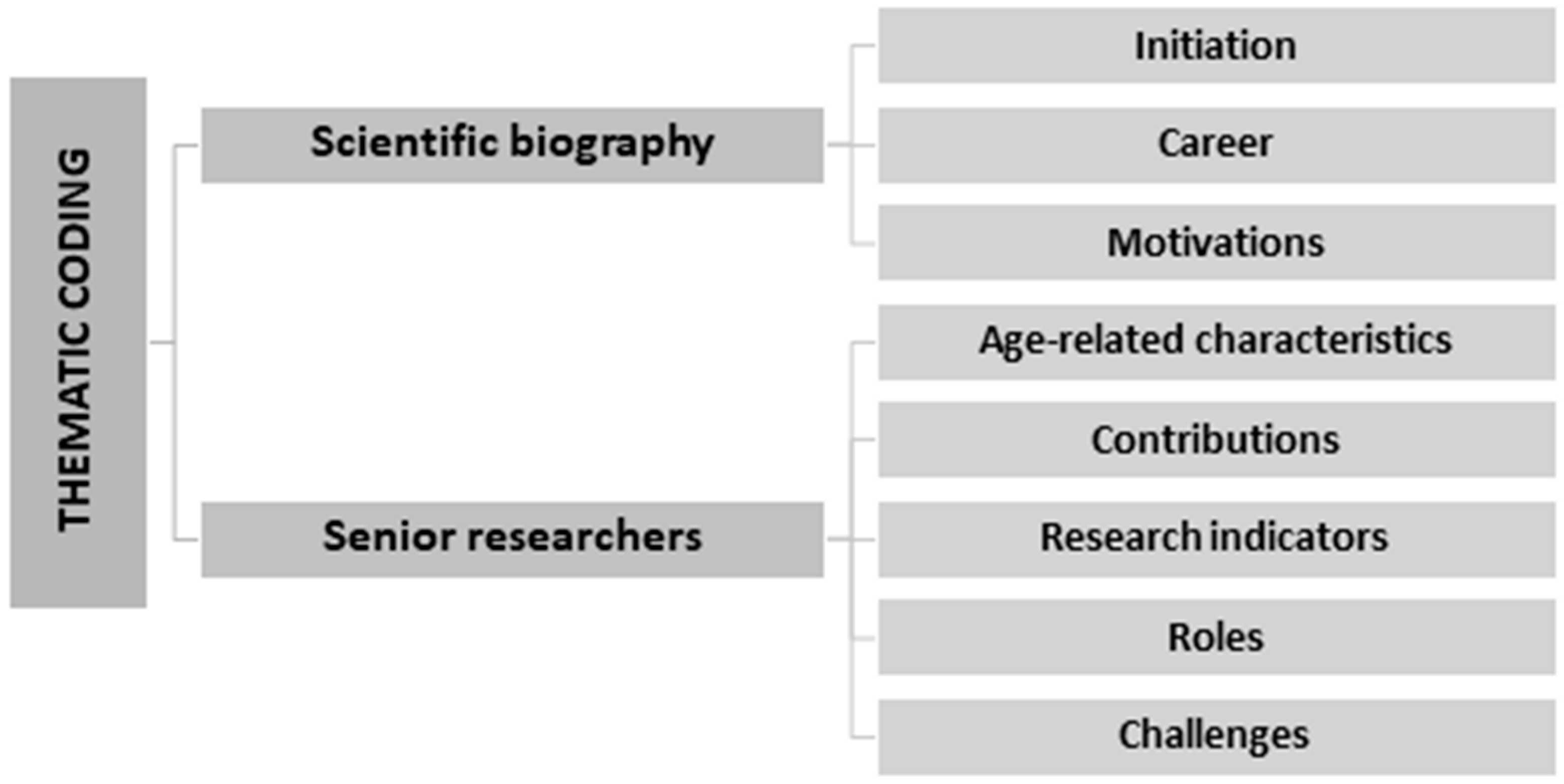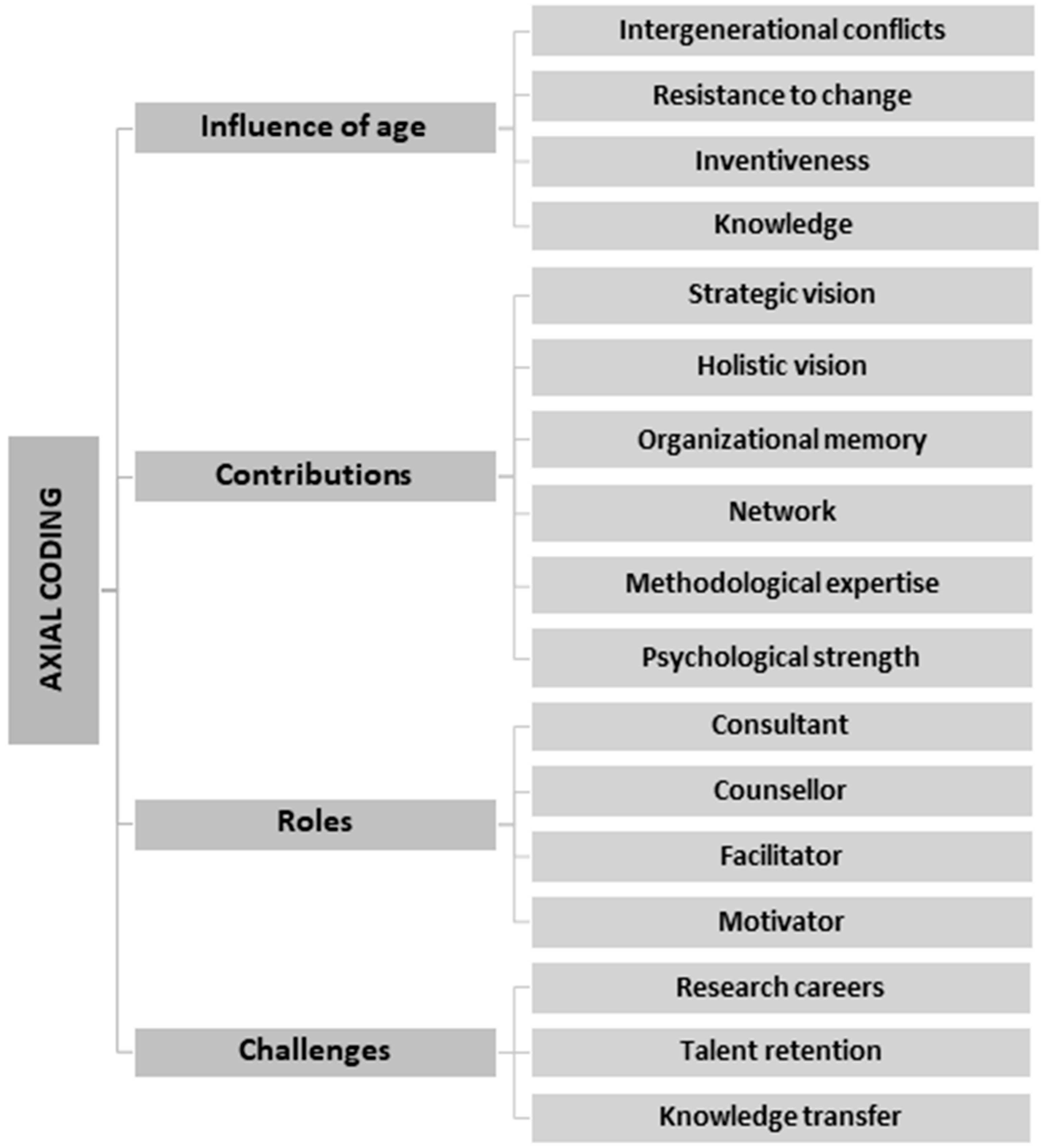Tacit Contributions and Roles of Senior Researchers: Experiences of a Multinational Company
Abstract
1. Introduction
2. Literature Review
2.1. Age and Individual Productivity
2.2. Age and Firm-Level Productivity
2.3. Tacit Contributions of Senior Inventors
2.4. Role of Senior Researchers
3. Materials and Methods
4. Results and Discussion
4.1. Scientific Productivity along the Professional Career
4.2. Tacit Contributions of Senior Researchers
“[Senior researchers] have a lot of knowledge and work with so many subjects.”(Interview number 4)
“[Senior researchers] can avoid reinventing the wheel: that’s also something I’ve faced with [young] people coming with a good idea, but such an idea has been already known for 20 years in another domain or in another lab, and they are reinventing the wheel. With more experienced people, they know what the real level of prior art is, not only inside the organisation, but outside as well.”(Interview number 6)
4.3. Roles of Senior Researchers
5. Challenges around Senior Researchers
“A person in R&D has different needs than somebody with a different vocation: having the freedom to investigate and to search, to increase his knowledge and to open new lines of work, are subjects that R&D people value more than those in other sectors.”(Interview number 8)
“Regarding money, after a certain limit where you cover all your needs, other factors enter to fill the job satisfaction, as an example, some work that becomes technically interesting.”(Interview number 2)
“Even if it is a difficult duty to be performed by the researchers in the organisation, there should exist a task that consists of generating research management structures in inter-generational teams, so that any [knowledge] transfer is done naturally and not within a month of departure notice [in the case of retirement or job change], in which is impossible to share a whole working life or long years of work”(Interview number 1)
6. Conclusions and Future Research
Author Contributions
Funding
Institutional Review Board Statement
Informed Consent Statement
Data Availability Statement
Acknowledgments
Conflicts of Interest
References
- Abbidin, Norhasni Zainal. 2006. Mentoring and Coaching: The Roles and Practices. SSRN Electronic Journal. [Google Scholar] [CrossRef][Green Version]
- Al-Zoubi, Mohammad Orsan, Ala’Aldin Alrowwad, and Raed Masadeh. 2019. Exploring the relationships among tacit knowledge sharing, mentoring and employees’ abilities. The case of Al-Hikma pharmaceutical company in Jordan. VINE Journal of Information and Knowledge Management Systems 50: 34–56. [Google Scholar] [CrossRef]
- Appelbaum, Steven H., Richard Wenger, Carolina Pachon Buitrago, and Ravneet Kaur. 2016. The effects of old-age stereotypes on organizational productivity (part one). Industrial and Commercial Training 48: 181–88. [Google Scholar] [CrossRef]
- Baker, Sarah Elsie, and Rosalind Edwards. 2012. How Many Qualitative Interviews Is Enough? Expert Voices and Early Career Reflections on Sampling and Cases in Qualitative Research. Working Paper. National Centre of Research Methods Review Paper. Available online: https://eprints.ncrm.ac.uk/id/eprint/2273/4/how_many_interviews.pdf (accessed on 25 July 2022).
- Blind, Knut, Ellen Filipović, and Luisa K. Lazina. 2022. Motives to Publish, to Patent and to Standardize: An Explorative Study Based on Individual Engineers’ Assessments. Technological Forecasting and Social Change 175: 121420. [Google Scholar] [CrossRef]
- Bryant, Scott E. 2005. The Impact of Peer Mentoring on Organizational Knowledge Creation and Sharing. Group & Organization Management 30: 319–38. [Google Scholar] [CrossRef]
- Buenechea-Elberdin, Marta. 2017. Structured literature review about intellectual capital and innovation. Journal of Intellectual Capital 18: 262–85. [Google Scholar] [CrossRef]
- Chatterjee, Sheshadri, Ranjan Chaudhuri, Alkis Thrassou, and Georgia Sakka. 2022. Impact of firm’s intellectual capital on firm performance: A study of Indian firms and the moderating effects of age and gender. Journal of Intellectual Capital 23: 103–26. [Google Scholar] [CrossRef]
- Chen, Mavis Yi-Ching, Yung Shui Wang, and Vicky Sun. 2012. Intellectual capital and organizational commitment: Evidence from cultural creative industries in Taiwan. Personnel Review 41: 321–39. [Google Scholar] [CrossRef]
- Choong, Kwee Keong. 2008. Intellectual capital: Definitions, categorization and reporting models. Journal of Intellectual Capital 9: 609–38. [Google Scholar] [CrossRef]
- Choudhury, Prithwiraj. 2017. Innovation Outcomes in a Distributed Organization: Intrafirm Mobility and Access to Resources. Organization Science 28: 339–54. [Google Scholar] [CrossRef]
- Cohen, Joshua G., Alexander E. Sherman, Tuyen K. Kiet, Daniel S. Kapp, Kathryn Osann, Lee-May Chen, Patricia S. O’Sullivan, and John K. Chan. 2012. Characteristics of success in mentoring and research productivity—A case–control study of academic centers. Gynecologic Oncology 125: 8–13. [Google Scholar] [CrossRef] [PubMed]
- Costas, Rodrigo, Thed N. van Leeuwen, and María Bordons. 2010. A bibliometric classificatory approach for the study and assessment of research performance at the individual level: The effects of age on productivity and impact. Journal of the American Society for Information Science and Technology 61: 1564–81. [Google Scholar] [CrossRef]
- Dunham, Annette H., and Christopher D. B. Burt. 2011. Organizational memory and empowerment. Journal of Knowledge Management 15: 851–68. [Google Scholar] [CrossRef]
- Eaton, Thelma. 1964. Bibliographical Research, Library Trends 13 (1) 1964: Research Methods in Librarianship: 42–53. Graduate School of Library and Information Science. University of Illinois at Urbana-Champaign. Available online: http://hdl.handle.net/2142/6162 (accessed on 3 March 2022).
- Edvinsson, Leif, and Michael S. Malone. 1997. Intellectual Capital: Realizing Your Company’s True Value by Finding Its Hidden Brainpower. New York: Harper Collins. [Google Scholar]
- Eisenhardt, Kathleen M., and Melissa E. Graebner. 2007. Theory Building from Cases: Opportunities And Challenges. Academy of Management Journal 50: 25–32. [Google Scholar] [CrossRef]
- Fallah, M. Hosein, Piyasi Choudhury, and Tugrul U. Daim. 2012. Does movement of inventors between companies affect their productivity? Technology in Society 34: 196–206. [Google Scholar] [CrossRef]
- Frosch, Katharina H. 2011. Workforce Age and Innovation: A Literature Survey. International Journal of Management Reviews 13: 414–30. [Google Scholar] [CrossRef]
- Ginesti, Gianluca. 2019. Top management characteristics and intellectual capital performance in small Italian companies. Corporate Governance 19: 1153–66. [Google Scholar] [CrossRef]
- Gonzalez-Brambila, Claudia, and Francisco M. Veloso. 2007. The determinants of research output and impact: A study of Mexican researchers. Research Policy 36: 1035–51. [Google Scholar] [CrossRef]
- Goodwin, Thomas H., and Raymond D. Sauer. 1995. Life Cycle Productivity in Academic Research: Evidence from Cumulative Publication Histories of Academic Economists. Southern Economic Journal 61: 728–43. [Google Scholar] [CrossRef]
- Hall, Bronwyn, Christian Helmers, Mark Rogers, and Vania Sena. 2014. The Choice between Formal and Informal Intellectual Property: A Review. Journal of Economic Literature 52: 375–423. [Google Scholar] [CrossRef]
- Hobson, Andrew J. 2012. Fostering Face-to-face Mentoring and Coaching. In The SAGE Handbook of Mentoring and Coaching in Education. Edited by Sarah J. Fletcher and Carol A. Mullen. London: SAGE, pp. 59–73. [Google Scholar]
- Hopkins-Thompson, Peggy A. 2000. Colleagues Helping Colleagues: Mentoring and Coaching. NASSP Bulletin 84: 29–36. [Google Scholar] [CrossRef]
- Jotabá, Mariana Namen, Cristina I. Fernandes, Marjaana Gunkel, and Sascha Kraus. 2022. Innovation and human resource management: A systematic literature review. European Journal of Innovation Management 25: 1–18. [Google Scholar] [CrossRef]
- Kram, Kathy E. 1983. Phases of the Mentor Relationship. Academy of Management Journal 26: 608–25. [Google Scholar] [CrossRef]
- Kristandl, Gerhard, and Nick Bontis. 2007. Constructing a definition for intangibles using the resource based view of the firm. Management Decision 45: 1510–24. [Google Scholar] [CrossRef]
- Landaeta, Rafael E., and Timothy G. Kotnour. 2008. Formal mentoring: A human resource management practice that supports knowledge transfer across projects. International Journal of Learning and Intellectual Capital 5: 455–75. [Google Scholar] [CrossRef]
- Lee, Ahreum, Ram Mudambi, and Marcelo Cano-Kollmann. 2016. An analysis of Japan’s connectivity to the global innovation system. Multinational Business Review 24: 399–423. [Google Scholar] [CrossRef]
- Luthy, D. H. 1998. Intellectual capital and its measurement. Paper presented at Asian Pacific Interdisciplinary Research in Accounting Conference (APIRA), Osaka, Japan, July 1–3; pp. 16–17. [Google Scholar]
- Manolopoulos, Dimitris, Pavlos Dimitratos, and Emmanouil Sofikitis. 2011. Predictors of career preferences of MNC knowledge professionals. Personnel Review 40: 466–84. [Google Scholar] [CrossRef]
- Mariani, Myriam, and Marzia Romanelli. 2007. “Stacking” and “picking” inventions: The patenting behavior of European inventors. Research Policy 36: 1128–42. [Google Scholar] [CrossRef]
- Mathew, Mary, and Nilanjana Bhaduri Nee Chakraborty. 2012. Aspirations of Indian inventors moderated by patenting experience, age and sector. The Journal of High Technology Management Research 23: 71–81. [Google Scholar] [CrossRef]
- McAdam, Rodney, Bob Mason, and Josephine McCrory. 2007. Exploring the dichotomies within the tacit knowledge literature: Towards a process of tacit knowing in organizations. Journal of Knowledge Management 11: 43–59. [Google Scholar] [CrossRef]
- McNiff, Kath. 2016. What Is Qualitative Research? The NVivo Blog. Burlington: QSR International. [Google Scholar]
- Merriam, Sharan B., and Robin S. Grenier. 2002. Qualitative Research in Practice: Examples for Discussion and Analysis. San Francisco: Jossey-Bass Publishers. [Google Scholar]
- Miles, Matthew B., A. Michael Huberman, and Johnny Saldaña. 2020. Qualitative Data Analysis: A Methods Sourcebook, 4th ed. Thousand Oaks: Sage Publications, Inc. [Google Scholar]
- Mothe, Caroline, and Thuc Uyen Nguyen-Thi. 2021. Does age diversity boost technological innovation? Exploring the moderating role of HR practices. European Management Journal 39: 829–43. [Google Scholar] [CrossRef]
- Nonaka, Ikujiro. 1994. A Dynamic Theory of Organizational Knowledge Creation. Organization Science 5: 14–37. [Google Scholar] [CrossRef]
- Ogura, Seiritsu, and Mihajlo Jakovljević. 2014. Health Financing Constrained by Population Aging: An Opportunity to Learn from Japanese Experience. Serbian Journal of Experimental and Clinical Research 15: 175–81. [Google Scholar] [CrossRef]
- Ortt, J. Roland, and Patrick A. van der Duin. 2008. The evolution of innovation management towards contextual innovation. European Journal of Innovation Management 11: 522–38. [Google Scholar] [CrossRef]
- Osinski, Marilei, Paulo Mauricio Selig, Florinda Matos, and Darlan José Roman. 2017. Methods of evaluation of intangible assets and intellectual capital. Journal of Intellectual Capital 18: 470–85. [Google Scholar] [CrossRef]
- Parise, Marc R., and Monica L. Forret. 2008. Formal mentoring programs: The relationship of program design and support to mentors’ perceptions of benefits and costs. Journal of Vocational Behavior 72: 225–40. [Google Scholar] [CrossRef]
- Park, Jisung, and Seongsu Kim. 2015. The differentiating effects of workforce aging on exploitative and exploratory innovation: The moderating role of workforce diversity. Asia Pacific Journal of Management 32: 481–503. [Google Scholar] [CrossRef]
- Pedro, Eugénia, João Leitão, and Helena Alves. 2018. Intellectual capital and performance: Taxonomy of components and multi-dimensional analysis axes. Journal of Intellectual Capital 19: 407–52. [Google Scholar] [CrossRef]
- Polanyi, Michael. 1958. Personal Knowledge: Towards a Post-Critical Philosophy. Chicago: Routledge & Kegan Paul Ltd. [Google Scholar]
- Rietzschel, Eric F., Hannes Zacher, and Wolfgang Stroebe. 2016. A Lifespan Perspective on Creativity and Innovation at Work. Work, Aging and Retirement 2: 105–29. [Google Scholar] [CrossRef]
- Rorstad, Kristoffer, and Dag W. Aksnes. 2015. Publication rate expressed by age, gender and academic position—A large-scale analysis of Norwegian academic staff. Journal of Informetrics 9: 317–33. [Google Scholar] [CrossRef]
- Saldaña, Johnny. 2021. The Coding Manual for Qualitative Research. Newbury Park: SAGE Publications Ltd. [Google Scholar]
- Schettino, Francesco, Alessandro Sterlacchini, and Francesco Venturini. 2013. Inventive productivity and patent quality: Evidence from Italian inventors. Journal of Policy Modeling 35: 1043–56. [Google Scholar] [CrossRef]
- Senker, Jacqueline. 2008. The contribution of tacit knowledge to innovation. Ai & Society 7: 208–24. [Google Scholar] [CrossRef]
- Short, Tom William. 2014. Workplace mentoring: An old idea with new meaning (part 1). Development and Learning in Organizations: An International Journal 28: 8–11. [Google Scholar] [CrossRef]
- Simonton, Dean Keith. 1997. Creative productivity: A predictive and explanatory model of career trajectories and landmarks. Psychological Review 104: 66. [Google Scholar] [CrossRef]
- Singh, Val, Divindra Bains, and Susan Vinnicombe. 2002. Informal Mentoring as an Organisational Resource. Long Range Planning 35: 389–405. [Google Scholar] [CrossRef]
- Single, Peg Boyle, and Carol B. Muller. 2001. When Email and Mentoring Unite: The Implementation of a Nationwide Electronic Mentoring Program. In Creating Mentoring and Coaching Programs. Edited by Linda K. Stromei. Alexandria: American Society for Training & Development. Available online: www.uvm.edu/~pbsingle (accessed on 8 August 2022).
- St-Pierre, Josée, and Josée Audet. 2011. Intangible assets and performance. Journal of Intellectual Capital 12: 202–23. [Google Scholar] [CrossRef]
- Sturman, Michael C. 2003. Searching for the Inverted U-Shaped Relationship Between Time and Performance: Meta-Analyses of the Experience/Performance, Tenure/Performance, and Age/Performance Relationships. Journal of Management 29: 609–40. [Google Scholar] [CrossRef]
- Sugimoto, Cassidy R., Thomas J. Sugimoto, Andrew Tsou, Staša Milojević, and Vincent Larivière. 2016. Age stratification and cohort effects in scholarly communication: A study of social sciences. Scientometrics 109: 997–1016. [Google Scholar] [CrossRef]
- Sung, Sun Young, and Jin Nam Choi. 2021. Contingent effects of workforce diversity on firm innovation: High-tech industry and market turbulence as critical environmental contingencies. The International Journal of Human Resource Management 32: 1986–2012. [Google Scholar] [CrossRef]
- Swap, Walter, Dorothy Leonard, Mimi Shields, and Lisa Abrams. 2001. Using Mentoring and Storytelling to Transfer Knowledge in the Workplace. Journal of Management Information Systems 18: 95–114. [Google Scholar] [CrossRef]
- Thomas, Asha, and Vikas Gupta. 2022. Tacit knowledge in organizations: Bibliometrics and a framework-based systematic review of antecedents, outcomes, theories, methods and future directions. Journal of Knowledge Management 26: 1014–41. [Google Scholar] [CrossRef]
- Tremblay, Michel, Thierry Wils, and Caroline Proulx. 2002. Determinants of career path preferences among Canadian engineers. Journal of Engineering and Technology Management 19: 1–23. [Google Scholar] [CrossRef]
- Tschang, F. Ted, and Gokhan Ertug. 2016. New Blood as an Elixir of Youth: Effects of Human Capital Tenure on the Explorative Capability of Aging Firms. Organization Science 27: 873–92. [Google Scholar] [CrossRef]
- Wang, Zhining, and Nianxin Wang. 2012. Knowledge sharing, innovation and firm performance. Expert Systems with Applications 39: 8899–908. [Google Scholar] [CrossRef]
- Wang, Yong, Cheng-Hung Tsai, David D. Lin, Oyunjargal Enkhbuyant, and Juan Cai. 2019. Effects of Human, Relational, and Psychological Capitals on New Venture Performance. Frontiers in Psychology 10: 1071. [Google Scholar] [CrossRef]
- Wikström, Ewa, Ellinor Eriksson, Lejla Karamehmedovic, and Roy Liff. 2018. Knowledge retention and age management—Senior employees’ experiences in a Swedish multinational company. Journal of Knowledge Management 22: 1510–26. [Google Scholar] [CrossRef]
- Woo, Hyung Rok. 2017. Exploratory Study Examining the Joint Impacts of Mentoring and Managerial Coaching on Organizational Commitment. Sustainability 9: 181. [Google Scholar] [CrossRef]
- Yaseen, Saad G., Dima Dajani, and Yasmeen Hasan. 2016. The impact of intellectual capital on the competitive advantage: Applied study in Jordanian telecommunication companies. Computers in Human Behavior 62: 168–75. [Google Scholar] [CrossRef]
- Yin, Robert K. 2017. Case Study Research and Applications: Design and Methods. Thousand Oaks: Sage Publications, Inc. [Google Scholar]
- Zwick, Thomas, Katharina Frosch, Karin Hoisl, and Dietmar Harhoff. 2017. The power of individual-level drivers of inventive performance. Research Policy 46: 121–37. [Google Scholar] [CrossRef]





| Interview Number | Age | Sex | Professional Experience | Career | Scientific Productivity |
|---|---|---|---|---|---|
| 1 | 46–50 | M | 21–25 | Researcher-R&D manager | Decreasing |
| 2 | 51–55 | F | 21–25 | Researcher-R&D manager | Decreasing |
| 3 | 46–50 | M | 21–25 | Researcher-R&D manager | Decreasing |
| 4 | 36–40 | M | 5–10 | Researcher | Decreasing |
| 5 | 51–55 | M | 31–35 | Researcher-R&D manager | Decreasing |
| 6 | 51–55 | F | 26–30 | R&D manager | - |
| 7 | 41–45 | M | 16–20 | Professional-Researcher | Constant |
| 8 | 36–40 | M | 11–15 | Researcher | Concentrated |
| 9 | 41–45 | M | 11–15 | Researcher | Concentrated |
| 10 | 41–45 | M | 21–25 | Professional-Researcher | Concentrated |
| 11 | 41–45 | M | 16–20 | Researcher | Concentrated |
| Personal Motivations | Organisational Motivations |
|---|---|
|
|
| Specific Competencies of Senior Researchers in an Industrial Organisation | |
|---|---|
|
|
| Roles of Senior Researchers in an Industrial Organisation | |
|---|---|
|
|
Publisher’s Note: MDPI stays neutral with regard to jurisdictional claims in published maps and institutional affiliations. |
© 2022 by the authors. Licensee MDPI, Basel, Switzerland. This article is an open access article distributed under the terms and conditions of the Creative Commons Attribution (CC BY) license (https://creativecommons.org/licenses/by/4.0/).
Share and Cite
Pérez Villa, W.; Pérez-Ezcurdia, A.; Vigil Berrocal, M.A. Tacit Contributions and Roles of Senior Researchers: Experiences of a Multinational Company. Adm. Sci. 2022, 12, 192. https://doi.org/10.3390/admsci12040192
Pérez Villa W, Pérez-Ezcurdia A, Vigil Berrocal MA. Tacit Contributions and Roles of Senior Researchers: Experiences of a Multinational Company. Administrative Sciences. 2022; 12(4):192. https://doi.org/10.3390/admsci12040192
Chicago/Turabian StylePérez Villa, Walter, Amaya Pérez-Ezcurdia, and Miguel Angel Vigil Berrocal. 2022. "Tacit Contributions and Roles of Senior Researchers: Experiences of a Multinational Company" Administrative Sciences 12, no. 4: 192. https://doi.org/10.3390/admsci12040192
APA StylePérez Villa, W., Pérez-Ezcurdia, A., & Vigil Berrocal, M. A. (2022). Tacit Contributions and Roles of Senior Researchers: Experiences of a Multinational Company. Administrative Sciences, 12(4), 192. https://doi.org/10.3390/admsci12040192





